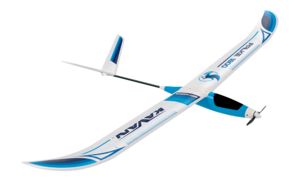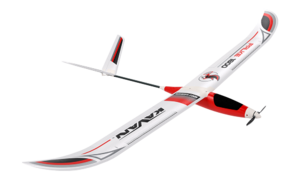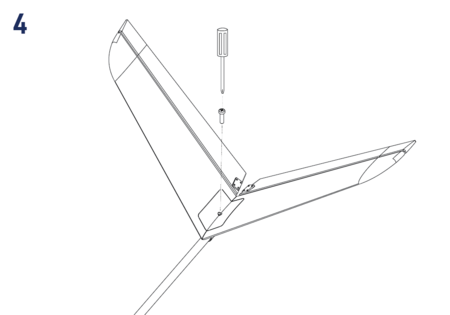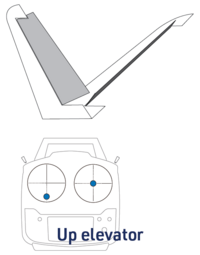KAVAN Falke 1800mm ARF - Návod ke stavbě
Úvod
Blahopřejeme vám k zakoupení vysokovýkonného motorového větroně FALKE 1800. Stali jste se majiteli modelu s konstrukcí z takřka nerozbitného pěnového EPO (extrudovaný polyolefin) poháněného výkonným střídavým motorem napájeným z LiPo akumulátorů. Každý, kdo již zvládá létání s modelem s křidélky, si stoprocentně užije pilotáž tohoto ušlechtilého vysokovýkonného termického větroně!
Ještě než začnete
- Pokud zatím nejste zkušený pilot RC modelů, začněte vyhledávat zkušeného modeláře, který před prvním vzletem zkontroluje váš nový model, zalétá jej a vytrimuje a poskytne vám pomoc během prvních letů. RC modely jsou přece jen poněkud složité, a zkušený modelář může rychle prověřit váš model - a vy získáte jistotu, že úspěchu prvních letů nestojí nic v cestě.
- Prosíme, model sestavujte přesně podle návodu. Nepokoušejte se model jakýmkoliv způsobem upravovat nebo měnit, protože tím můžete způsobit zhoršení jeho letových vlastností. Pokud provedete jakékoliv úpravy, které nejsou v souladu s tímto návodem, činíte tak výhradně na svoji vlastní odpovědnost.
- Než začnete, prosím, zkontrolujte celý obsah stavebnice podle návodu, abyste měli jistotu, že žádná část nechybí nebo není poškozena. Při rozbalování postupujte, opatrně, nic zbytečně neroztrhávejte a nerozřezávejte - nepočínejte si, prosím, jako netrpělivá novomanželka při rozbalování svatebních darů. Tímto způsobem se také lépe seznámíte se všemi částmi modelu. Pokud zjistíte, že nějaký díl chybí nebo je poškozený, prosím, neprodleně kontaktujte prodejce, u kterého jste model zakoupili.
- Každý díl před nalepením na místo vyzkoušejte. Před montáží se ujistěte, že používáte správný díl a že dobře sedí. Žádné množství lepidla nemůže nahradit špatně padnoucí díl.
- Návod obsahuje zřetelně vyznačenou polohu těžiště a doporučené výchozí velikosti výchylek ovládacích ploch. Dodržení správné polohy těžiště je naprosto zásadní podmínkou pro to, aby byl model ovladatelný a letuschopný. Správnou polohu je nutno bezpodmínečně dodržet. Pro první vzlet model zkompletujte tak, aby těžiště odpovídalo údaji v návodu - to je bezpečná hodnota pro zkušeného pilota, který je seznámen s chováním modelu v plném rozsahu běžných letových rychlostí. Těžiště více vpředu znamená model „hodnější“, stabilnější a snáze ovladatelný. Zadní poloha těžiště značí model „živější“, s menší stabilitou, s rychlejšími reakcemi na řízení a celkově náročnější na ovládání - proto je vhodné začít s přední polohou těžiště, a teprve poté, co s pilotáží modelu seznámíte a sžijete, můžete začít experimentovat.
Bezpečnostní opatření
Tento RC model není hračka. Používejte jej opatrně a důsledně dodržujte pokyny uvedené v tomto návodu.
Model sestavte přesně podle tohoto návodu. Model NEMODIFIKUJTE ani neupravujte. V opačném případě záruka automaticky zaniká. Postupujte podle pokynů, abyste na konci montáže získali bezpečný a pevný model.
Osoby mladší 14 let smějí model používat pouze pod dohledem dospělé osoby.
Před každým letem se ujistěte, že je model v perfektním stavu. Dbejte na to, aby veškeré vybavení fungovalo správně a aby model neměl poškozenou konstrukci.
Fly only on days with a light breeze and in a safe place away from any obstacles.
Safety precautions and warnings
- An RC aeroplane is not a toy! If misused, it can cause serious bodily harm and damage to property. Fly only in a safe place and follow all instructions and recommendations in this manual. Beware of the propeller! Keep loose items that can get entangled in the propeller away from the spinning propeller, including loose clothing, or other objects such as pencils and screwdrivers. Ensure that your and other people's hands and face are kept away from the rotating propeller.
- As the user of this product, you are solely responsible for operating it in a manner that does not endanger yourself and others or result in damage to the product or the property of others. This model is controlled by a radio signal that is subject to interference from many sources outside your control. This interference can cause momentary loss of control, so it is advisable to always keep a safe distance in all directions around your model, as this margin will help to avoid collisions or injury.
- Never operate your model with low transmitter batteries.
- Always operate your model in an open area away from power lines, cars, traffic or people. Avoid operating your model in populated areas where injury or damage can occur.
- Carefully follow the directions and warnings for this and any optional support equipment (chargers, rechargeable batteries, etc.) which you use.
- Keep all chemicals, small parts and anything electrical out of the reach of children.
- Moisture causes damage to electronics. Avoid water exposure to all equipment not specifically designed and protected for this purpose.
- The model is mostly made of plastics – it is not fireproof. It may not be exposed to higher temperatures, otherwise severe distortion of the foam airframe or other damage may occur.
Specification
| Wingspan | 1800 mm |
| Length | 1150 mm |
| Wing area | 27 dm² |
| All-up weight | 660–710 g |
| Motor | C2714–1450 |
| ESC | KAVAN R–20B BEC |
| Propeller | 7×6" |
Set contents
• Almost ready-to-fly model of a sailplane with the brushless motor, speed controller and servos installed, instruction manual.
You will also need
- At least 4-channel RC set featuring V-tail mix, 11.1 V 1200–1600 mAh LiPo flight pack.
- Regular modeller’s tools - modeller’s knife, screwdrivers, 1.5 and 2 mm Allen key, pliers etc.
Model assembly
- Locate the steel wire wing joiner (note the "V" shape ensuring the correct wing dihedral) and slide both wing halves onto the joiner. (Fig. 1)
- Connect the aileron servo cables to the corresponding extension cables in the wing opening in the fuselage. (Fig. 2)Note: The kit is supplied with a Y-cable for ailerons so you can use even the most basic 4-channel radios to control your FALKE 1800. If you intend to use independent control of aileron servos and an advanced computer radio, you will have to replace the default Y-cable with two 25–30 cm extension cables.
- Attach the plastic wing joiner and secure the wing to the fuselage with two M5×20 mm nylon bolts. (Fig. 3)
- Attach the V-tail planes to the tailplane seat and secure them with the plastic joiner and M3 hex screw to the fuselage. (Fig. 4)
- Connect the plastic quick links to the ruddervator horns. (Fig. 5)
- The flight pack is to be placed in the bay in the centre of the cockpit; use a Hook-and-loop tie to fasten it. You can place your receiver (secured with a strip of Hook-and-loop or double-sided foam tape) behind the flight pack. Connect servos and your ESC to the receiver; deploy the antennas so their active parts are square to each other (if you are using a receiver featuring diversity antennas). With your radio on, set the servos to the neutral position (sticks and trims centred) - screw in or out the quick links as needed. Perform the throttle range calibration of the ESC as described in the attachment of this manual. (Fig. 6)
- Attach the canopy.
RC set installation and preflight check
- Referring to the instruction manual of your radio carefully hook up the onboard electronics.
- Once everything has been correctly connected, turn on your transmitter and plug in the flight pack. Check the neutral positions and throws of all control surfaces - double-check the correct set-up of the V-tail mix. If you need to make the control surface throws smaller, simply move the pushrod closer to the centre on the servo arm or move it far from the control surface on the control horn. And vice versa.
| Low rate | High rate | |
| Ailerons | 10 mm up/5 mm down 1 | 13 mm up/ 7 mm down |
| Ailerons (Airbrake) | 10 mm up | 10 mm up |
| Elevator | ± 7 mm | ± 10 mm |
| Elevator (Airbrake) | 2 mm up | 2 mm up |
| Rudder | ± 10 mm | ± 13 mm |
- The "Low rate" recommended control surface throws are suitable for a less skilled pilot and regular soaring. The "High rate" setting allows an experienced pilot to explore the full capabilities of his model. The aileron differential (aileron down deflection reduced to 50 % of up deflection) is only possible with a computer radio.
- Check the direction of rotation of the propeller. If it was incorrect, simply swap two of the three wires between the ESC and motor or program the ESC (refer to the ESC manual).
- Check the correct position of the centre of gravity (CG) – 56–63 mm behind the leading edge of the wing (Fig. 7). Adjust the CG position by moving the flight pack - if you could not reach the recommended position, do not hesitate to add an appropriate amount of lead to the nose or tail. An extra couple of grams won’t spoil the flying characteristics - but the incorrect CG position is a killer.
- Fully charge your flight pack and transmitter batteries, check the proper function of your radio and perform the range check of your radio according to its instruction manual. The range has to be almost the same with the motor off and at full throttle (no more than a 10 % decrease is acceptable). DO NOT try to fly unless the range check is 100 % successful.
Flying
The test flying and fine-tuning is pretty much straightforward, there will be no surprise for a medium-advanced pilot that is supposed to fly this model.
Recycling and waste disposal note (European Union)

Electrical equipment marked with the crossed-out waste bin symbol must not be discarded in the domestic waste; it should be disposed of via the appropriate specialised disposal system. In the countries of the EU (European Union) electrical devices must not be discarded via the normal domestic waste system (WEEE - Waste of Electrical and Electronic Equipment, Directive 2012/19/EU). You can take your unwanted equipment to your nearest public collection point or recycling centre, where it will be disposed of in the proper manner at no charge to you. By disposing of your old equipment in a responsible manner you make an important contribution to the safeguarding of the environment!
EU declaration of conformity (European Union)

Hereby, KAVAN Europe s.r.o. declares that the model FALKE and the included electronic and electric devices are in compliance with the requirements of relevant European directives and harmonized norms. The full text of the Declaration of Conformity is available at www.kavanrc.com/doc/.
Guarantee
The KAVAN Europe s.r.o. products are covered by a guarantee that fulfils the currently valid legal requirements in your country. If you wish to make a claim under guarantee, please contact the retailer from whom you first purchased the equipment. The guarantee does not cover faults which were caused in the following ways: crashes, improper use, incorrect connection, reversed polarity, maintenance work carried out late, incorrectly or not at all, or by unauthorised personnel, use of other than genuine KAVAN Europe s.r.o. accessories, modifications or repairs which were not carried out by KAVAN Europe s.r.o. or an authorised KAVAN Europe s.r.o., accidental or deliberate damage, defects caused by normal wear and tear, operation outside the Specification, or in conjunction with equipment made by other manufacturers. Please be sure to read the appropriate information sheets in the product documentation!












